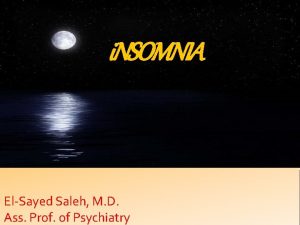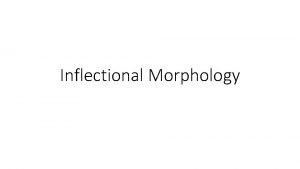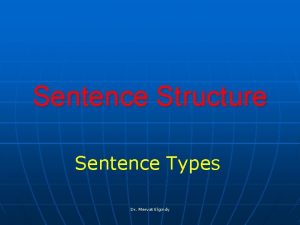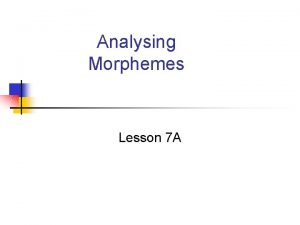Morphology Morphemes Dr Mervat Elgindy Morphology is the







- Slides: 7

Morphology Morphemes Dr. Mervat Elgindy

• Morphology is the study of the internal structure of words and of the rules by which words are formed. • Morpheme is the minimal unit of meaning or grammatical function (past tense and plural). Ex. Tourists contains 3 morphemes. Tour + ist +s Dr. Mervat Elgindy

Free and Bound Morphemes • Free Morphemes can stand by themselves as single words. Ex Tour, open , stay … • Bound Morphemes can not normally stand alone but they are typically attached to another form. Affixes are bound morphemes. Ex. re- , -ist , -ed , -s … Dr. Mervat Elgindy

Prefixes and Suffixes • Some affixes have to be added to the beginning of a word. These are called PREFIXES. Ex. Mislead • Some affixes have to be added to the end of the word. They are called SUFFIXES. Ex. respectful Dr. Mervat Elgindy

Lexical and Functional Morphemes • Free morphemes fall into two categories : 1. Lexical morphemes are the ordinary nouns adjectives and verbs which carry the content of messages we convey. Ex. Sad, long, look 2. Functional morphemes are the functional words in the language such as conjunctions, prepositions, articles and pronouns. Ex. and, but, on, near, above Dr. Mervat Elgindy

Derivational and Inflectional Morphemes Bound Morphemes can also be divided into two types: 1. Derivational morphemes are used to make new words of a different grammatical category from the stem. Ex. good => adjective good + ness noun 2. Inflectional morphemes are used to indicate aspects of the grammatical function of a word. Plural markers (sisters), possessive markers (Tom’s sister), tense markers (played), comparative and superlative markers (older) are inflectional morphemes.

Reference: Yule, G. (2006). The study of Language. Cambridge University Press. Dr. Mervat Elgindy












